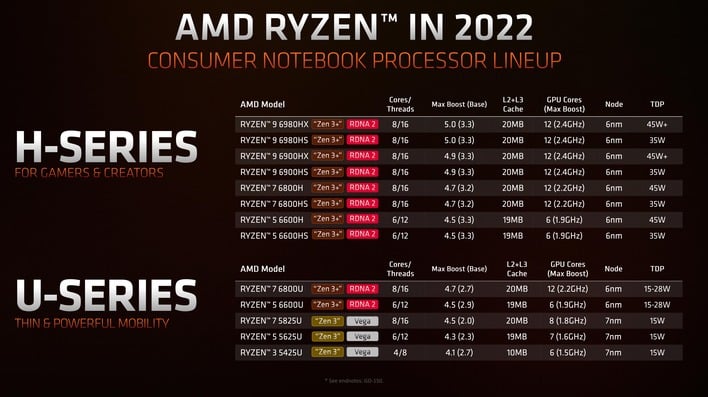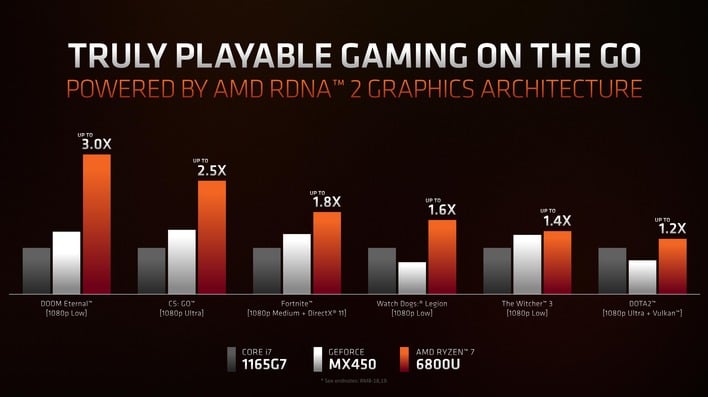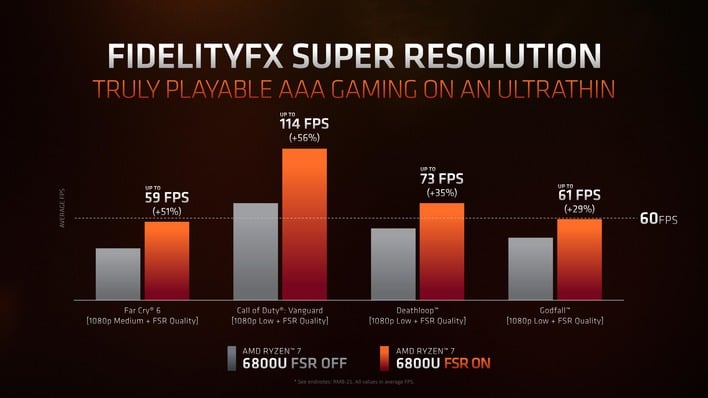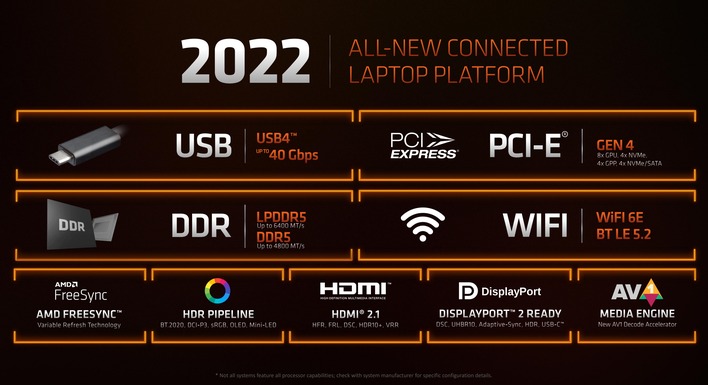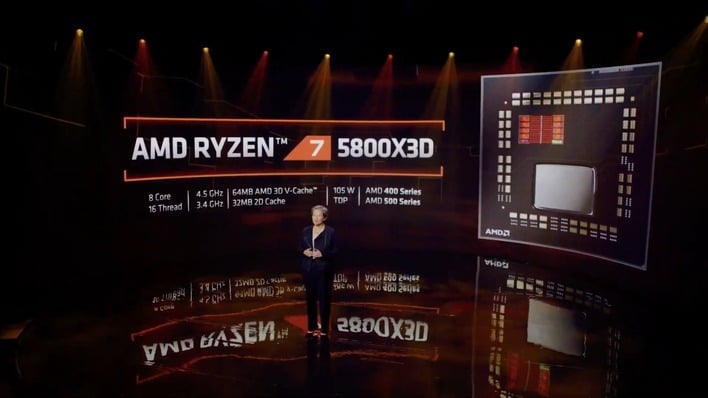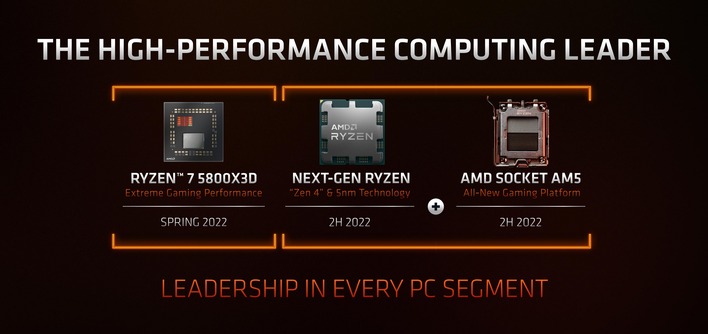AMD’s CES CPU Assault Brings Ryzen 6000 Mobile With RDNA 2, Ryzen 7 5800X3D, Zen 4 Platform Reveal

It's no secret to anyone that Ryzen has been a runaway success for AMD. The company touted 30% growth in its PC unit, with 49% growth in notebooks over the last two years and some 350 million PC shipped with AMD CPUs in 2021—a record for the company. Where once you could only find cheaply-built budget laptops bearing AMD chips, these days the company enjoys placement in a full range of products from economical to premium. AMD says its partners have over 150 "ultrathin, commercial, and gaming" laptops with its CPUs.
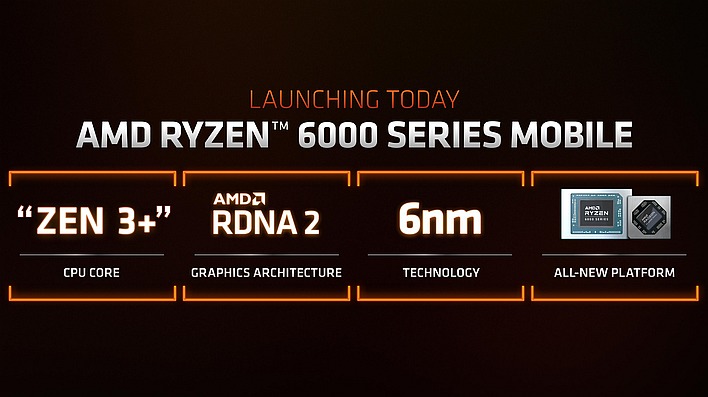
 Team Red expects to grow that number with its new Ryzen 6000 Series mobile chips. These processors—codenamed "Rembrandt"—are the culmination of AMD's latest and greatest IP in both CPU and GPU design, with refined Zen 3+ CPU cores and integrated graphics based on the same RDNA 2 architecture found in its Radeon RX 6000 family of GPUs. Refinements to its own technologies as well as TSMC's fabrication process (leading them to call it "6nm") have allowed AMD to ramp up clock speeds and reduce power consumption all at once.
Team Red expects to grow that number with its new Ryzen 6000 Series mobile chips. These processors—codenamed "Rembrandt"—are the culmination of AMD's latest and greatest IP in both CPU and GPU design, with refined Zen 3+ CPU cores and integrated graphics based on the same RDNA 2 architecture found in its Radeon RX 6000 family of GPUs. Refinements to its own technologies as well as TSMC's fabrication process (leading them to call it "6nm") have allowed AMD to ramp up clock speeds and reduce power consumption all at once.Specifically, AMD notes that the fastest Ryzen 6000 Mobile family chips will hit 5GHz under full boost, with graphics parts clocking all the way up to 2.4GHz. Those numbers, along with refinements in the CPU and the move to RDNA 2 graphics, means that the new CPUs are some 30% faster than the last generation in general computing, and fully twice as fast in gaming—at least by AMD's reckoning. Here's a chart with the full specifications of the Ryzen 6000 mobile CPUs:
A chart showing all of the Ryzen 6000 Mobile models. (Click to enlarge.)
As you can see, there's twelve different new models coming, although only nine of the chips are based on AMD's new Rembrandt processor. At the top end we have the Ryzen 9 6980HX, differentiated from the Ryzen 9 6980HS only by their TDP ratings. That's a trend across the chart; "HS" CPUs are slightly lower-power at 35W, while "H" CPUs are 45W, and "HX" CPUs can apparently scale up beyond that, likely in a larger chassis with hefty cooling and discrete graphics.
Not that you necessarily need discrete graphics. While the gains in CPU performance that AMD cites are pretty impressive for a release with neither major architecture changes nor a new node—10% in Cinebench ST, 30% in Cinebench MT, and 30% in PCMark 10—it's really the graphics performance that impresses on these processors.
These numbers are all straight from AMD so take them with however many grains of salt that you wish, but the red team claims that the ULV Ryzen 7 6800U can take a 60% lead over the Core i7-1165G7's Iris Xe graphics in Watch Dogs: Legion, an 80% lead in Fortnite, and offer fully triple the performance in Doom Eternal, among other games. Of course, the Intel chip in this testing is saddled with slower DDR4 memory; main memory bandwidth is usually the bottleneck in this kind of testing. Those numbers apparently also put the Ryzen 7 6800U ahead of the discrete GeForce MX 450 in all of the games tested, although the gap is a bit smaller.
As we just noted, the narrowest bottleneck for integrated graphics performance tends to be not the GPU core itself, but rather the fact that it has to share the already-slow main system memory with the CPU. One of the things with the biggest impact on memory bandwidth requirements is rendering resolution. That makes upscaling technologies like FSR a natural fit for integrated graphics, and indeed, AMD was keen to show that off.
Demonstrating Far Cry 6 running on a laptop equipped with a Ryzen 7 6800U, the company raised performance by half-again simply toggling FSR onto the "quality" setting. In our own testing, we found FSR's "quality" mode to be a completely acceptable compromise for games that were marginal on performance, and in this case, AMD's laptop was able to handle the game at 60 FPS with 1080p "Medium" settings. That's pretty darn good for a game as recent as Far Cry 6 on integrated graphics.
It's also worth noting that these are the first x86-64 processors ever made with support for ray-tracing hardware-acceleration. (PowerVR had RT acceleration in its mobile GPUs some years back.) It remains to be seen whether these IGPs are powerful enough to make use of that functionality in commercial games, but at least it's there.
Besides the new CPU and GPU bits, AMD's Ryzen 6000 Mobile processors bring along a whole new platform. As expected, it makes use of DDR5 memory up to 4800MT/s, or LPDDR5 up to 6400MT/s—a tantalizing option for those looking at compact gaming systems. It also supports USB 4, offering immense throughput at up to 40 Gbps. PCIe on the new chips is still Gen 4, but that's already more bandwidth than the overwhelming majority of laptops can even make use of.
AMD notes HDMI 2.1 support, but correctly includes the specific technologies supported: HFR, FRL, DSC, VRR, and HDR10+, which is to say "everything." AMD also mentions that Rembrandt is "DisplayPort 2 Ready", and specifically indicates support for accelerated decoding of the AV1 video format. AV1 is a hyper-efficient video codec that is mathematically-complex enough to make it absolutely painful to encode and decode using raw CPU power, so having decode support in these APUs is a big deal.

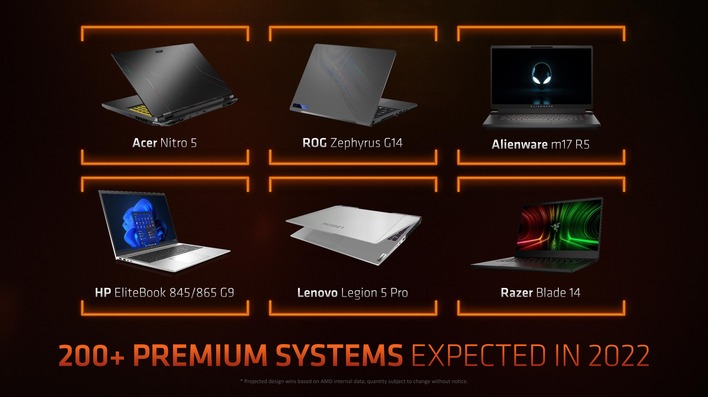
Shoring Up Desktop Performance With Stacked Silicon
Even though the focus of AMD's CPU presentation was on the Ryzen 6000 Mobile processors, there were a few goodies for desktop enthusiasts. The biggest one would have to be the announcement of an actual consumer product with AMD's much-anticipate 3D V-cache onboard: the Ryzen 7 5800X3D.
Clumsy name aside, this is fundamentally the exact same Ryzen 7 5800X eight-core CPU that we all know and love with an extra 64MB of L3 cache bolted on. It should work in motherboards based on the 400-series and 500-series chipsets, which is to say that most motherboards that support the 5800X should also support the 5800X3D. Curiously, the Ryzen 7 5800X3D does run slightly slower clock rates than the classic 5800X: 3.4GHz base and 4.5GHz boost, where the original 5800X is spec'd for 3.8GHz base and 4.7GHz boost.
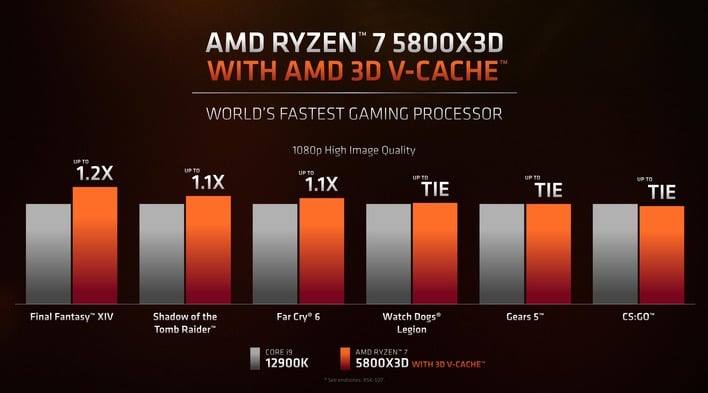
One detail that AMD didn't provide about the Ryzen 7 5800X3D is its price. The company did give us a vague idea of when it will be released, though: this Spring. Hopefully sooner than later, because otherwise we might end up in a situation rather similar to when Intel released the Core i7-5775C just weeks away from the Core i7-6700K. The former CPU's big cache allowed it to hold its own rather well against the newer CPU, and if Zen 4 doesn't come with stacked cache, it could make for an interesting comparison.

Oh, and speaking of Zen 4, AMD demoed it on stage today. It wasn't really a testament to anything besides the fact that it is real and AMD has working silicon, but the company's live demo of Halo Infinite was super-smooth, anyway. Zen 4 will be fabricated on TSMC's 5nm process, and AMD says that the chips, which will be called the Ryzen 7000 series, will top a 5GHz all-core clock during gameplay.
Confirming what we've known for quite some time, Zen 4 will be coming along with a brand new platform called, predictably, AM5. AM5 will support PCI Express 5.0 and DDR5 memory, but it will change from a Micro-PGA socket (the CPU socket type used on AM4) to an LGA 1718 socket. Despite this change, it will retain compatibility with Socket AM4 CPU coolers, meaning you don't have to throw out that expensive custom water loop yet.
AMD says that the next-gen Ryzen CPUs (with Zen 4 cores) and their accompanying Socket AM5 platform will show up in the second half of this year. The company seems confident it can attain or retain "leadership in every PC segment," which is a strong statement when your competition is Intel. Still, it's impossible to deny the strides AMD has made in the last few years. Whatever happens, we're always excited to see the sparks flying when these two titans clash.

